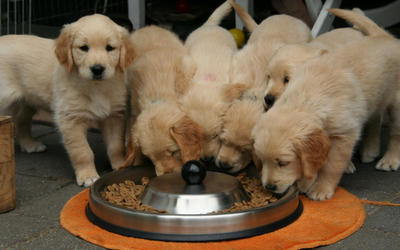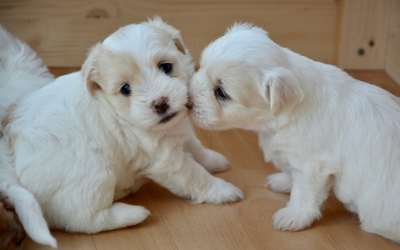
There are lots of choices of dog foods. What should I feed my puppy?
Diet is extremely important during the growing months of a dog's life. It is recommended that your puppy is fed a name-brand food made by a national dog food company (not a generic or local brand) and a diet made for puppies. This should be fed until your puppy is about twelve to eighteen months of age, depending on its breed and size. You should only buy brands that have been certified by an independent organization as complete and balanced. In the United States, you should look for food that has been certified by AAFCO, an independent organization that oversees the entire pet food industry and certifies that the food has met the minimum requirements for nutrition. In Canada, look for foods approved by the Canadian Veterinary Medical Association (CVMA) or foods that are labeled as having undergone rigid testing with food trials. For optimal brain and eye development, the puppy food should contain high levels of DHA (docosahexaenoic acid), an omega-3 fatty acid.
Feeding a dry, canned, or semi-moist form of puppy food is acceptable as long as the label states that the food is intended for growth and/or development and is "complete and balanced." This means that the food is nutritionally complete and meets the needs of growth and development.
Each of the types of food has advantages and disadvantages. Dry food is definitely the most inexpensive. It can be left in the dog's bowl without spoilage for longer periods of time than canned or moist foods. Semi-moist foods may be acceptable, depending on their quality. The texture may be more appealing to some dogs, and they often have a stronger odor and flavor.
However, semi-moist foods are often high in sugar and calories and should be carefully chosen based on their nutritional qualities rather than taste, packaging, or consistency. Canned foods are a good choice to feed your dog, but are considerably more expensive than either of the other forms of food.
Canned foods contain a high percentage of water, and their texture, odor, and taste are very appealing. However, canned food will dry out or spoil if left out for prolonged periods of time. Canned food is generally more suitable for meal feeding rather than free choice feeding.
Table or people foods are not usually recommended for pets. Because they are usually very tasty, dogs will often begin to refuse their well-balanced dog food in favor of table food. If you choose to give your puppy table food, be sure that at least ninety percent of his diet is from a quality commercial puppy food. If not, follow a properly formulated recipe that has been developed by a formally trained veterinary nutritionist.
We enjoy a variety of things to eat in our diet. However, most dogs actually prefer not to change from one food to another unless they are trained to do so by the way you feed them. Do not feel guilty if your dog is happy eating the same food day after day, week after week.
"Commercials for dog food can be very misleading"
Commercials for dog food can be very misleading. If you watch carefully, you will notice that commercials often promote dog food based on taste, shape, or consistency. Nutrition is rarely mentioned. Most of the "gourmet" foods are marketed to appeal to owners who want the best for their dogs; however, they do not offer the dog any nutritional advantage over a good quality dry food, and they are far more expensive. If you read the labels of many of the gourmet foods, you will notice that they do not claim to be "complete and balanced." If your dog eats a gourmet food for very long, it is at a risk of developing nutritional deficiencies and weight problems. If your puppy requires a special diet due to a health problem later in life, it is also very unlikely to accept it.
How often should I feed my puppy?
"Meal feeding means that the puppy is fed at specific times of the day."
There are several "right" ways to feed puppies. The most popular method is commonly called "meal feeding". This means that the puppy is fed at specific times of the day. A measured amount of food should be offered four times per day for five to twelve week old puppies. What is not eaten within thirty minutes is taken away. If the food is eaten within three to four minutes, the quantity is probably not sufficient. Puppies fed in this manner generally begin to cut back on one of those meals by three to four months of age and perhaps another as they get older. Usually the puppy will appear less hungry at one of its meals; if this occurs for several days in a row, it is time to discontinue that meal. Two meals per day is the optimal feeding schedule for adult dogs.
"Free choice feeding," means that food is available at all times. This works well with dry foods and for some dogs. However, other dogs tend to overeat and become overweight or obese. If there is weight gain after the optimal size is reached at around twelve to eighteen months of age, this method of feeding should be discontinued.
What is normal play behavior of a healthy puppy?
"Running, chasing, and fetching are important play behaviors in puppies and are necessary for proper muscular development."
It is very important that you provide stimulating play for your puppy, especially during the first week in its new home. Running, chasing, and fetching are important play behaviors in puppies and are necessary for proper muscular development. Chewing and biting are common ways for puppies to investigate new things. Your puppy will be less likely to use family members or their possessions for these activities if you provide adequate puppy-safe toys. The best toys are lightweight, pliable, and durable, without attachments such as eyes that can be bitten off and swallowed. Any toy that is small enough to be swallowed should be avoided. Your veterinarian can help you choose the safest toys for your new puppy if you unsure what is safe or the appropriate size for your puppy.
How should I discipline a puppy?
Disciplining a young puppy may be n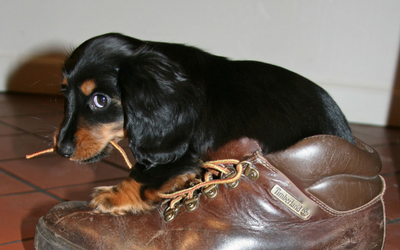
How do I housebreak my new puppy?
Housebreaking should begin as soon as your puppy enters his new home. How long the training must continue depends on both the puppy and you. Some pups are housebroken faster than others. Your dog wants to please you. But a puppy's memory is short, so your patience is important. A home with a poorly trained puppy is not a happy home for you or the puppy.
The simplest way to housebreak a puppy is to use "crate-training". The puppy's bed may be a box or crate, open at one end and slightly larger than the puppy. If the crate is too large, the puppy may defecate or urinate in a corner of the crate rather than go outside when training occurs. If the crate is smaller, the puppy will more likely do his "business" outside rather than soil its bed. You may place a box or other space-occupying object in the back of the crate to make it smaller and remove it as the puppy grows in size. Enclose the bed or crate in a small area, such as a laundry room. Cover this area with newspapers just in case an "accident" spills or leaks outside the crate during the night or when your pet is left unsupervised.
Another common housebreaking tool is creating a "scent post." A scent post is naturally created when your puppy urinates and defecates in any place. This is one of the reasons puppies will return to the area of an "accident" in the house and repeatedly urinate or defecate in that area. The solution is to locate the scent post in the place you want it.
To create a scent post, take the puppy to the area in the yard where you want them defecate and urinate. Leave a small amount of feces in this area. First thing in the morning, the puppy should be quickly taken to the scent post. This is so he can learn his way to the door and the scent post. Let him sniff about. The moment he has relieved himself, praise him with a pat on the head and immediately bring him into the house. Do not let him play about. The toilet period and play period should be definitively separated in the puppy's routine.
After relieving himself, the puppy should be fed. In a short while, the puppy will become uneasy and walk in circles sniffing at the floor. The puppy should then be taken to the scent post as quickly as possible. This routine should be repeated every hour or two throughout the day, especially after meals, naps, and playtimes.
When the puppy is taken out to play, it is wise to leave the house by another door and avoid taking him near his scent post. Never play with your pup until after he has been taken out and has eliminated.
There will of course be some "accidents" in the house during the first few weeks. Do not scold or otherwise verbally punish your pet. Scolding him even 5 minutes after the offense is too late - the puppy will only associate the scolding with your presence at the same time as the "accident", not your displeasure at the mishap. Keep in mind it is far more effective to reward good behavior than to scold unwanted behaviors. Any soiled areas in the house must be scrubbed thoroughly until all odors are gone. Your veterinarian can recommend cleaning products that will help neutralize any scent from urination or defecation.
Positive reinforcement of proper urine and bowel habits is just as important as properly applied discipline. When your puppy urinates or defecates in the correct place, spend a moment stroking his head and praising him.
How do I ensure that my puppy is well socialized?
The socialization period for dogs generally occurs between four and twelve weeks of age. During that time, the puppy is very impressionable to social influences. If it has good experiences with men, women, children, cats, other dogs, and so forth, it is likely to accept them throughout life. If the experiences are absent or unpleasant, it may become apprehensive or adverse to any of them. Therefore, during the period of socialization, you are encouraged to expose your dog to as many types of social events and influences as possible. Puppy "kindergarten" and puppy training classes are ideal opportunities to socialize your pup. It is important to ensure your puppy is only being socialized with healthy, fully vaccinated animals until they have completed their puppy vaccines. Please consult with your veterinarian to determine what social interactions would be appropriate for your puppy.
My puppy seems to be constantly chewing. Why does this occur?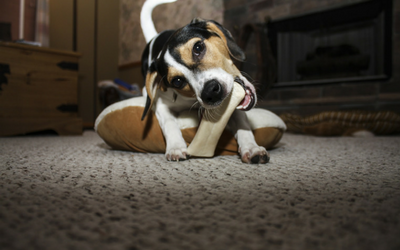
Chewing is a normal puppy behavior. Almost all of a puppy's 28 baby teeth are present by about 4 weeks of age. They begin to fall out at about 3 ½ to 4 months of age and are replaced by the 42 adult (permanent) teeth by about 6-7 months of age. Therefore, chewing is a puppy characteristic that you can expect until at least 6-7 months of age, if not longer. It is important that you do what you can to direct your puppy's chewing toward acceptable objects. You should provide puppy-safe items such as nylon chew bones and other chew toys so other objects are spared. Avoid hard rubber or plastic toys as they can break teeth, and avoid bones since they can fragment and become obstructed in the intestinal tract.
My puppy has episodes of hiccupping and a strange odor to its breath. Is this normal?
"Puppies experience episodes of hiccupping..."
Yes. Many puppies experience episodes of hiccupping that may last several minutes when they are young. This is normal and only lasts a few weeks or months. All puppies have a characteristic odor to their breath that is commonly called "puppy breath". Some of the distinctive odor is caused by teething. This odor is normal and will last only until the puppy matures in a few months.
How should I trim my puppy's toenails?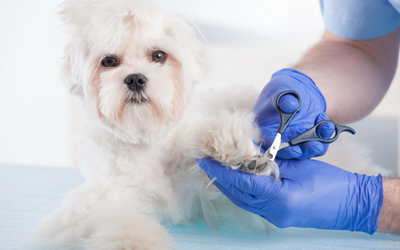
"When cutting nails, use sharp trimmers."
Puppies have very sharp toenails. When the puppy is young, you can use your fingernail or toenail clippers to trim off the sharp tips. As the puppy gets older, you will need to use nail trimmers made for dogs. If you take too much off the nail, you will cut into the "quick" and bleeding and pain will occur. If this happens, neither you nor your dog will want to do this again. Some guidelines for nail trimming include:
- If your dog has clear or white nails, you can often see the pink of the quick through the nail. If you avoid the pink area, you should be safely away from the quick.
- If your dog has black nails, you will not be able to see the quick so only cut 1/32" (1 mm) of the nail at a time until the dog begins to get sensitive. The sensitivity will usually occur before you cut into the blood vessel. With black nails, it is likely that you will get too close on at least one nail. With some nails, you can have an assistant use a flashlight to illuminate the side of the nail to determine where the quick is, and use that as a guide.
- If your dog has some clear and some black nails, use the average clear nail as a guide for cutting the black ones.
- When cutting nails, use sharp trimmers. Dull trimmers tend to crush the nail and cause pain even if you are not in the quick.
You should always have styptic powder (a clotting substance) available. This is sold in pet stores under several trade names, but it will be labeled for use in trimming nails.
Are there any emergency tips I should know?
There are several emergency situations that you may encounter. For details on First Aid and Emergencies in dogs, see the separate handouts "Common Emergencies in Dogs” and "First Aid for Dogs". With any emergency, contact your veterinarian immediately for specific emergency instructions, and take the pup to the veterinary clinic as soon as possible. General first aid information that you should know includes the following:
1. In any emergency situation, keep the pet as quiet as possible and try to conserve heat by covering it with bedding or newspapers.
2. Before attempting to administer any form of first aid, muzzle the dog. In an emergency, a leash or piece of rope can be looped around the dog's muzzle to prevent biting.
3. If the pet is bleeding from a wound, attempt to stop the bleeding by covering the wound with a clean absorbent bandage and applying direct pressure directly over the wound.
4. For burns and scalds, flush with cool water; cover any open areas with a clean dressing.


